I’ve had the opportunity to listen for the first time, or in
some cases again, to Vlado Perlemuter’s entire legacy on Nimbus.
These recordings vary in date and in location; the majority
derive from sessions at Wyastone Leys but some were also taped
in Birmingham studios. The sound quality of these performances,
from 1974 to digital as it were, has often been noted and calls
for a brief comment from me. It is certainly the case that the
rather swimmy acoustic is a prominent and really rather unwelcome
feature of a number of the discs. However I wouldn’t want to
allow this demerit to overshadow the quality of the performances.
These too vary. The late recordings do show digital frailties,
but Perlemuter was in his late eighties, and technical perfection,
if such a thing exists, is hardly the Alpha and Omega in the
appreciation of the art of so distinguished a musician. He was
up to the challenges of most the repertory, most of the time.
Chopin occupies the bulk of these discs but I would also direct
you to the Ravel recordings which are consistently illuminating,
exceptionally well played, and historically important.
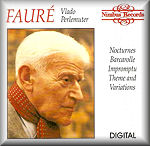 Gabriel
FAURÉ (1845-1924)
Gabriel
FAURÉ (1845-1924)
Thème et Variations Op.73 (1897) [14:03]
Nocturnes Nos. 1-13 (published 1882-1921); No.1 Op.33 No.1 [6:17]:
No.6 Op.63 [7:58]; No.7 Op.74 [7:48]; No.12 Op.107 [5:44]; No.13
Op.119 [6:44]
Impromptus; No.2 in F minor Op.31 [4:00]: No.5 in F sharp minor
Op.102 [2:25]
Barcarolle No.5 in F sharp minor Op.66 [6:00]
Vlado Perlemuter (piano)
rec. March and September 1982, Wyastone Leys
NIMBUS NI 5165 [61:04]
Buy
through MusicWeb for £12 postage
paid World-wide.
Musicweb
Purchase button Sound
Clips and Downloads
His Fauré is a delight. There is a noble dignity to his Thème
et Variations which is neither as fast as Kathleen Long
nor as spacious as Germaine Thyssens-Valentin, to take two pianists
of the older generation who were flourishing in the 1940s and
1950s when Perlemuter was a younger man. The occasional finger
slips are more than compensated for by virtue of his sense of
line, texture and sonority. The First Nocturne reveals a template
of his playing as a whole – unmannered directness devoid of
extraneous romanticised gestures but revealing a sure awareness
of the structural implications of the writing and its expressive
potential. He keeps the left hand rocking in the Sixth, in D,
ensuring the melody line remains spruce and uncluttered. This
playing probably didn’t find favour with those who preferred
a more malleable and obvious gestural response but Perlemuter’s
way here is to highlight melodic highs and refuse to homogenise
the textures. He is never bland and never boring. So, yes, the
Seventh Nocturne may seem terse and unreflective but it has
its own rewards and stance. The Twelfth has breathless momentum
leavened by assured rubati. Pedalling is equally brisk. The
Second Impromptu is rightly playful and the Fifth Barcarolle
has great brio, and is taken at a perfect tempo (Thyssens-Valentin
and Collard variously agree in their recordings).
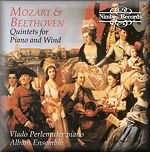 Ludwig
van BEETHOVEN (1770-1827)
Ludwig
van BEETHOVEN (1770-1827)
Quintet in E flat for piano and wind Op.16 (1796) [26:49]
Wolfgang Amadeus MOZART (1756-1791)
Quintet in E flat for piano and wind K452 (1784) [25:47]
Vlado Perlemuter (piano)
The Albion Ensemble
rec. June 1981, Wyastone Leys
NIMBUS NI5157 [53:35]
Buy
through MusicWeb for £12 postage
paid World-wide.
Musicweb
Purchase button Sound
Clips and Downloads
Perlemuter joined with members of The Albion Ensemble for
this unusual offering. It was the only chamber recording he
made with Nimbus. The ensemble was George Caird (oboe), Andrew
Marriner (clarinet), Jeremy Ward (bassoon) and Robin Martin
(horn). The playing here is relaxed, genial. Phrasing in the
Beethoven is unostentatious, and the heart of the Quintet, its
slow movement, is especially appealing in its measured generosity.
The ensemble is fine in the finale. In the Mozart we have more
evidence of a solid ensemble alliance and of leisurely refinement
once again. Neither of these readings is the most obviously
exciting on disc, but one can certainly enjoy the technical
accomplishment and the slightly self-effacing quality of the
music-making.
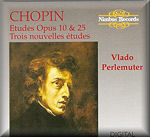 Fryderyk
CHOPIN (1810-1849)
Fryderyk
CHOPIN (1810-1849)
Etudes, Op. 10
No. 1 in C (Allegro) [2.23]
No. 2 in A minor (Allegro) [1.42]
No. 3 in E (Lento ma non troppo) [4.09]
No. 4 in C sharp minor (Presto) [.30]
No. 5 in G flat (Vivace) [1.59]
No. 6 in E flat minor (Andante)[3.19]
No. 7 in C (Vivace)[1.45]
No. 8 in F (Allegro)[2.51]
No. 9 in F minor (Allegro molto agitato) [2.13]
No. 10 in A flat (Vivace assai) [2.32]
No. 11 in E flat (Allegretto) [2.27]
No. 12 in C minor (Allegro con fuoco) [2.53]
Etudes, Op. 25
No. 1 in A flat (Allegro sostenuto) [2.26]
No. 2 in F minor (Presto) [1.39]
No. 3 in F (Allegro) [2.08]
No. 4 in A minor (Agitato) [1.45]
No. 5 in E minor (Vivace) [3.29]
No. 6 in G sharp minor (Allegro) [2.14]
No. 7 in C sharp minor (Lento) [4.50]
No. 8 in D flat (Vivace legato) [1.17]
No. 9 in G flat (Allegro vivace) [1.07]
No. 10 in B minor (Allegro con fuoco) [4.09]
No. 11 in A minor (Lento) [4.02]
No. 12 in C minor (Allegro molto, con fuoco) [2.58]
Trois nouvelles etudes
No. 1 in F minor (Andantino) [1.58]
No. 2 in D flat (allegretto) [1.57]
No. 3 in A flat (Allegretto) [1.47]
rec. tracks 1-12 and 25-27 on 28 and 29 March, 1983. Tracks
13-24 on 8 and 9 June, 1982 at Wyastone Leys, Monmouth
NIMBUS NI 5095 [68:29]
Buy
through MusicWeb for £12 postage
paid World-wide.
Musicweb
Purchase button Sound
Clips and Downloads
Perlemuter’s Chopin represents by far the most extensive part
of his Nimbus discography. It’s also the repertoire by which,
one assumes, posterity will best remember him, though my own
view is that his Ravel recordings are in a way more candid evidence
of his musicianship, and were, moreover, made earlier so better
preserve his virtuosic and digitally elevated musicianship at
its late peak. There are individual Chopin discs, and a 6 CD
boxed set which consolidates all his recordings for the company.
His Etudes vary in tempo decisions. The first two of the Op.10
set are quite deliberate whereas the third, in E, is up to tempo,
its contrary motion octaves dispatched with authority. There
is an unhurried nobility about the fifth, though No.7 can seem
somewhat impersonal. The Op.25 set sports a finely poetic A
flat, and a direct, affecting (within his limits) C sharp minor.
There’s marvellous pointing and a sense of colour in the – again
– deliberately phrased G flat.
 Nocturnes
Nocturnes
Op. 9 No. 3 in B major [5.39]
Op. 15 No. 1 in F major [4.14]
Op. 15 No. 2 in F sharp major [3.36]
Op. 15 No. 3 in G minor [4.51]
Op. 27 No. 1 in C sharp minor [4.55]
Op. 27 No. 2 in D flat major [4.54]
Op. 48 No. 1 in C minor [5.18]
Op. 48 No. 2 in F sharp minor [6.32]
Op. 55 No. 2 in E flat major [4.29]
Op. 62 No. 1 in E major [4.57]
rec. 28-29 January 1984, Nimbus Studios, Wyastone Leys
NIMBUS NI 5012 [50:07]
Buy
through MusicWeb for £12 postage
paid World-wide.
Musicweb
Purchase button Sound
Clips and Downloads
This selection of Nocturnes reveals Perlemuter’s aesthetic to
be decidedly different from his teacher Cortot, and indeed such
as, say, Rubinstein or Moravec. The sense of directness established
by his Fauré Nocturne recordings is apparent here too. This
can be heard not merely in linear directness but in a gimlet,
directional approach that eschews decorative sensibilities.
Thus his Op.9 No.3 is fast, almost terse. He lashes into the
central panel of Op.15 No.1 with vehemence, and there is natural
authority, clarity and subtle nuance in its Op. companion in
F sharp minor. His D flat major (Op.27 No.2) is lit by colour
shading, pellucid runs and a refined tonal palette. His Op.62
No.1 is extremely fast and will sound brusque to those weaned
on the pianists noted above.
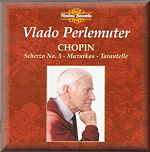 Scherzo
No. 3 in C sharp minor, Op. 39 [8.20]
Scherzo
No. 3 in C sharp minor, Op. 39 [8.20]
Mazurka in A minor, Op. 59 No. 1 [3.48]
Mazurka in A flat, Op. 59 No. 2 [2.38]
Mazurka in F sharp minor, Op. 59 No. 3 [4.02]
Mazurka in B, Op. 63 No. 1 [2.23]
Mazurka in F minor, Op. 63 No. 2 [2.03]
Mazurka in C sharp minor, Op. 63 No. 3 [2.03]
Mazurka in C, Op. 24 No. 2 [3.00]
Mazurka in B minor, Op. 33 No. 4 [5.00]
Mazurka in E minor, Op. 41 No. 1 [2.41]
Mazurka in C sharp minor, Op. 41 No. 4 [3.48]
Mazurka in C, Op. 56 No. 2 [1.45]
Mazurka in C minor, Op. 56 No. 3 [6.10]
Mazurka in F minor, Op. 68 No. 4 [2.03]
Mazurka in A minor, Op. 17 No. 4 [4.08]
Mazurka in C sharp minor, Op. 30 No. 4 [3.55]
Mazurka in C sharp minor, Op. 50 No. 3 [5.00]
Tarantelle in A flat, Op. 43 [3.41]
rec. Track 1 on 9 October 1990, Tracks 2-14 on 1-3 July 1992,
Tracks 15-17 on 21/22 May 1986, Track 18 on 29 March 1983 at
Wyastone Leys, Monmouth.
NIMBUS NI 5393 [66:33]
Buy
through MusicWeb for £12 postage
paid World-wide.
Musicweb
Purchase button Sound
Clips and Downloads
His Third Scherzo doesn’t have the fleetness or grand seigniorial
sense of fantasy of, say, Moiseiwitsch, whose mature 1949 recording
is considerably quicker but also more inimitable than Perlemuter’s
own. The Mazurkas are an intriguing case study. I find them
decidedly straight, as if he were involved on a demystifying
quest. Op.59 No.1 is too cut and dried, Op.63 No.2 is tonally
quite hard, up to tempo, but uningratiating. Op.68 No.4 is unruffled,
unaffected, unindulgent, rather matter of fact. Throughout,
in these works, his aesthetic is decidedly individualistic and
uncompromising, refusing to countenance intimacies or too many
inflexions.
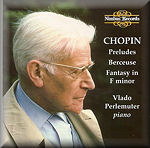 24
Preludes Op. 28
24
Preludes Op. 28
C major [0.36]
A minor [1.39]
G major [1.07]
E minor [1.36]
D major [0.39]
B minor [1.53]
A major [0.49]
F sharp minor [2.00]
E major [1.27]
C sharp minor [0.38]
B major [0.43]
G sharp minor [1.16]
F sharp major [2.59]
E flat minor [0.37]
D flat major [4.46]
B flat minor [1.20]
A flat major [3.15]
F minor [0.59]
E flat major [1.31]
C minor [1.42]
B flat major [2.16]
G minor [0.53]
F major [1.04]
D minor [2.35]
Prelude in C sharp minor Op. 45 [3.45]
Fantasy in F minor Op. 49 [12.35]
Berceuse Op. 57 [4.26]
rec. Preludes: March 1981 (Analogue Recording). Fantasy and
Berceuse: March 1982 (Digital Recording) at Wyastone Leys
NIMBUS NI5064 [59:10]
Buy
through MusicWeb for £12 postage
paid World-wide.
Musicweb
Purchase button Sound
Clips and Downloads
Here we find Perlemuter at his most consistent, his most consonant
and his most intriguing. He’s strong, virile when necessary
and he avoids any externalised romantic show. His Preludes have
an integrity about them which is not granitic but which impresses
through sheer authority. That said, his technique is not what
it was, and unsympathetic auditors will find some of these performances
too clinical in detail and too cool in feeling.
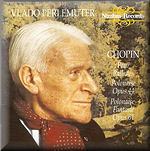 Ballade
No.1 in G minor Op.23 [9:10]
Ballade
No.1 in G minor Op.23 [9:10]
Ballade No.2 in F Op.38 [7:32]
Ballade No.3 in A flat Op.47 [7:24]
Ballade No.4 in F minor Op.52 [10:42]
Polonaise in F sharp minor Op.44 [10:37]
Polonaise-Fantasie in A flat Op.61 [11:46]
rec. 1977 and 1983 at Wyastone Leys
NIMBUS NI 5209 [57:11]
Buy
through MusicWeb for £12 postage
paid World-wide.
Musicweb
Purchase button Sound
Clips and Downloads
His Ballades offer a consistently more engaging balance between
expression and hauteur. Despite a few trivial slips, the G minor
is characterful and richly engrossing, and the equality of free-wheeling
drama and introspection embedded in the Second in F is purposefully
realised. The third Ballade is very fine indeed and the Fourth,
if anything, finer still in its sense of lyrical expression
and narrative drama. The Polonaises offer virtuosic flair. I
might be inclined to recommend this disc first to a newcomer
to his Chopin recordings. It is conspicuously intelligent playing,
tonally rich, musically elevated, wholly rewarding.
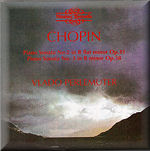 Piano
Sonata No.2 in B flat minor Op.35 [24:36]
Piano
Sonata No.2 in B flat minor Op.35 [24:36]
Piano Sonata in B minor Op.58 [25:24]
Barcarolle Op.60 [7:48]
rec. January 1974, Nimbus Studios, Birmingham and 8 March 1982
(Barcarolle), Wyastone Leys, Monmouth
NIMBUS NI 5038 [58:16]
Buy through MusicWeb for £12
postage paid World-wide.
Musicweb
Purchase button Sound
Clips and Downloads
This is an august pairing that shows Perlemuter to have retained
his fabled digital finesse well into the 1970s and beyond, though
his playing in 1974 is clearly and I think demonstrably superior.
Fortunately both sonatas were taped in 1974. The B minor is
captivating in its sectional control, tonal sophistication and
sense of characterisation. If it doesn’t aim at the highest
level of emotional involvement, then that was Perlemuter’s way.
The companion B flat minor [No.2] is a powerful study in contrasts,
with tonal beauty, a stratified sense of colour and a profoundly
moving funeral march at its heart.
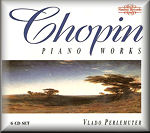 Chopin
Boxed set
Chopin
Boxed set
NIMBUS NI 1764 [6 CDs – contains all Chopin performances
as above, boxed] 
Buy through MusicWeb for £23
postage paid World-wide.
Musicweb
Purchase button
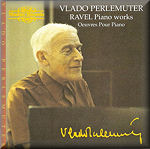 Maurice
RAVEL (1875-1937)
Maurice
RAVEL (1875-1937)
CD1
Noctuelles [4.45]
Oiseaux tristes [3.47]
Une Barque sur l'Océan [6.34]
Alborada del gracioso [6.24]
Vallée des cloches [5.03]
Jeux d'eau [5.32]
Pavane pour une Infante défunte [5.29]
Gaspard de la Nuit
Ondine [6.30]
Le gibet [6.15]
Scarbo [9.01]
CD2
Sonatine [11:22]
Valses Nobles et Sentimentales [14:07]
Le Tombeau de Couperin
Prélude [3.00]
Fugue [3.20]
Forlane [5.54]
Rigaudon [3.20]
Menuet [5.00]
Toccata [4.02]
Prélude [1.35]
A la Manière de Borodine [1.51]
A la Manière de Chabrier [1.56]
Menuet Antique [6.24]
Menuet sur le nom d'Haydn [2.07]
rec. 26 July-2 August 1973, Nimbus Studios, Birmingham
NIMBUS NI 7713/14 [59:20 + 64:12]
Buy
through MusicWeb for £12 postage
paid World-wide.
Musicweb
Purchase button Sound
Clips and Downloads
As noted elsewhere I’m convinced that Perlemuter’s Ravel is
the best of him in these Nimbus recordings, more even than the
raft of Chopin performances. Miroirs is a delight; Noctuelles
is full of evocative precision, and the poetic sensitivity
he evinces is propelled with unselfconscious control in these
early, 1973 recordings made in the studio. Textual control radiates
outwards from these traversals. As for Gaspard there’s
a total lack of fuss in Ondine – but the avoidance of
artifice is a function of the poetic hauteur that gives such
meaning to his playing. His Sonatine is crisp, the Valses
animated by an especially witty Vif whilst Le Tombeau
de Couperin moves with grace and deft accentuation, a notch
slower than the BBC 1970 broadcast that has circulated. Seeking
an analogue, this is the kind of pointillist playing George
Copeland brought to Debussy, in contradistinction to Gieseking’s
Turneresque wash; both wonderful but both very different. Perlemuter’s
Ravel is a breath of fresh air.
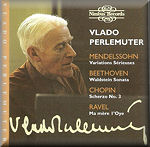 Ludwig
van BEETHOVEN (1770-1827)
Ludwig
van BEETHOVEN (1770-1827)
Sonata No. 21 in C major, Op. 53 'Waldstein' [25:57]
Fryderyk CHOPIN (1810-1849)
Scherzo No. 3 in C sharp minor, Op. 39 [8.21]
Felix MENDELSSOHN (1809-1847)
Variations Sérieuses in D minor, Op. 54 [12.15]
Maurice RAVEL (1875-1937)
Ma mère l'Oye; 5 Pièces enfantines pour Piano à 4 mains [13:07]
¹
Adrian Farmer (piano) ¹
rec. Tracks 1 - 3 recorded 9 to 11 October 1990, track 4 recorded
21 May 1986, tracks 5 - 9 recorded 9 March 1982, at Wyastone
Leys, Monmouth
NIMBUS NI 5340 [59:40]
Buy
through MusicWeb for £12 postage
paid World-wide.
Musicweb
Purchase button Sound
Clips and Downloads
A mixed salad recorded at four year intervals between 1982 and
1990. The Waldstein came last and is laboured. There
are a few trivial slips but, more importantly, there’s little
sense of con brio in the opening. He was 87 at the time
so this may go some way to explaining it. I assume the Third
Chopin Scherzo is the same as the one on NI5393 - or is it a
different performance? Mendelssohn’s Variations Sérieuses in
D minor dates from 1982 and represents fine playing, worthy
of admiration. So too the charming performance of Ma mère
l'Oye with Nimbus’s Adrian Farmer, whom Perlemuter insisted
play the top half. Perlemuter had played this work with Ravel
(Perlemuter playing the bottom half) and he also played it with
Jeanne Leleu who had given the first performance with Geneviève
Durony. Enough for a frisson, surely.
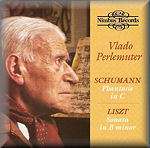 Robert
SCHUMANN (1810-1856)
Robert
SCHUMANN (1810-1856)
Phantasie in C major Op.17 [29:57]
Franz LISZT (1811-1886)
Piano Sonata in B minor [29:48]
rec. October 1974, Nimbus Studios, Birmingham (Liszt) and October
1990, Wyastone Leys, Monmouth (Schumann)
NIMBUS NI5299 [60:00]
Buy
through MusicWeb for £12 postage
paid World-wide.
Musicweb
Purchase button Sound
Clips and Downloads
Interesting, I suppose, that there is, in these performances,
ten seconds difference between the two very different works.
His Schumann was recorded when he was 86 but I don’t think you’d
know it. I referred in my introduction to the occasional technical
weakness but few are evident here. There is a real sense of
energy coursing through the bloodstream of this performance,
a sense of momentum and sweeping grandeur. One shouldn’t be
surprised that his Liszt takes a direct approach. With performances
of this work now regularly breaching 33 or 34 minutes, his 1974
recording – adroit, powerful – aims for cohesiveness, not localised
drama.
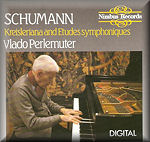 Robert
SCHUMANN (1810-1856)
Robert
SCHUMANN (1810-1856)
Kreisleriana Op.16 [30:50]
Etudes symphoniques Op.13 [28:45]
rec. June 1982 (Kreisleriana) and December 1985 (Etudes), Wyastone
Leys, Monmouth
NIMBUS NI 5108 [59:35]
Buy through MusicWeb for £12
postage paid World-wide.
Musicweb
Purchase button Sound
Clips and Downloads
Before Perlemuter recorded his powerful Phantasie (see above)
he’d visited Wyastone to set down his Kreisleriana and Etudes
symphoniques. He was 78 when he recorded the former, his technique
still strong, the playing direct, powerfully conceived and conceived
moreover in a concentrated arch. Never one for easy emoting,
this is not necessarily the most pliant cycle one will hear,
but that was never his aim. Similar virtues attend the Etudes
symphoniques which avoids sentiment and bombast equally. Some
may read into his playing, because of the biographical connections,
vestiges of Cortot’s Schumann playing, but Perlemuter was long
since his own man.
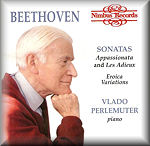 Ludwig
van BEETHOVEN (1770-1827)
Ludwig
van BEETHOVEN (1770-1827)
Piano Sonata in F minor Op.57 Appassionata [21:56]
Piano Sonata in E flat Op.81a Les Adieux [16:48]
Eroica Variations Op.35 [24:40]
rec. December 1987 (Appassionata, Les Adieux), Wyastone Leys,
Monmouth and 1974, Nimbus Studios, Birmingham (Eroica)
NIMBUS NI 5133 [63:25]
Buy
through MusicWeb for £12 postage
paid World-wide.
Musicweb
Purchase button Sound
Clips and Downloads
Perlemuter had carte blanche to record what he wanted from his
repertoire for Nimbus. He chose three Beethoven sonatas – the
Waldstein is on NI 5350 – and the Eroica variations,
the last of which derives from a Birmingham performance. What
is revealing about the Appassionata, in particular, is
Perlemuter’s explicit revelation of the harmonic implications
of the music, notably the left hand steps in the central movement.
What may seem didactic in other hands is here a study in carefully
balanced drama. One may not think of him as a Beethovenian,
but clearly he approached the few works he chose to record in
a spirit of precision and concentration.
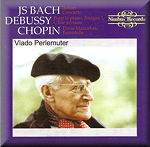 Johann
Sebastian BACH (1685-1750)
Johann
Sebastian BACH (1685-1750)
Italian Concerto BWV971 [12:35]
Claude DEBUSSY (1862-1918)
Pour le piano [14:22]
Images Book 1 [15:41]
L’Isle joyeuse [7:30]
Fryderyk CHOPIN (1810-1849)
Mazurka Op.17 No.4 [4:00]
Mazurka Op.30 No.4 [3:49]
Mazurka Op.50 No.3 [4:53]
Tarantelle Op.43 [3:40]
rec. December 1985, Wyastone Leys, Monmouth (Bach, L’Isle joyeuse,
Pour le piano except the Toccata); May 1986 (Pour le piano –
Toccata, Images, Chopin Mazurkas) and March 1983 (Tarantelle)
NIMBUS NI 5080 [65:30]
Buy
through MusicWeb for £12 postage
paid World-wide.
Musicweb
Purchase button Sound
Clips and Downloads
My Perlemuter Pilgrimage ends with this mixed volume. I was
interested to see that the Toccata from Pour le Piano
comes not from the December 1985 session but from one made in
May the following year. I assume either he didn’t record it
in December or (more likely?) he was dissatisfied with the results.
Inevitably Perlemuter slowed as he aged. There is a BBC broadcast
of Pour le piano from 1968 (issued in the BBC Music Magazine)
in which things are very much more vital and zestful, in which
articulation is crisper and the results very different from
the invariably more laboured playing here. Once again I don’t
get on with his Chopin Mazurkas; give me Friedman! His Bach
is affectionately direct, with attractive voicings and no overstressing.
This is a somewhat catch-all disc but it does preserve playing
of great character and imagination.
I’m sure no encouragement from me is necessary to acquire some
of these discs. Selectivity will prove rewarding. Enlightenment
will be permanent.
Jonathan Woolf

